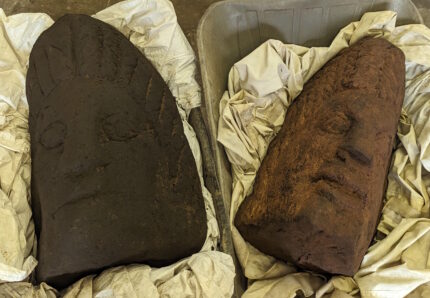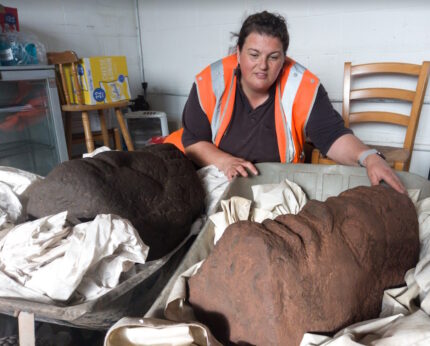The excavation of the sumptuous Roman bathhouse at the Carlisle Cricket Club has unearthed two monumental statue heads believed to date to the early 3rd century. The sandstone heads are two feet high, three times bigger than life-sized. Extrapolating from the size of the heads, archaeologists believe the original statues must have been between 12 and 15 feet high. These are the first sculptures unearthed at the site.

The heads were discovered yesterday, just two days after the new dig season began by volunteers Carolyn Veit and Ruth Pearce. They were found at the edge of a cobbled Roman road. They appear to have been purposely left there, placed side-by-side on the cobbled surface of the road. They were covered in dark soil when the road fell into disuse in the 5th century.
Archaeologists believe they may have been rejected spolia (ancient building materials stripped and repurposed for later construction), left by the roadside by people looting one of the huge structures in the bathhouse complex for its building materials.
Artifacts like tiles branded with the IMP stamp and an inscription dedicated to Julia Domna underscore the connection between the bath complex and the emperor Septimius Severus who was there in 208 A.D. during his military campaign against the Caledonian tribes north of Hadrian’s Wall. One possibility is that the heads, one of which is female and the other male, may be representations of Septimius Severus and his wife Julia Domna. The female figure has thick, wavy plaits, a hairstyle Julia Domna was famous for throughout the empire. Another possibility is that the monumental statues represented deities.
Lead archaeologist Frank Giecco said they were “unique and priceless”. […]
“In 30 years of being an archaeologist I’ve never found a thing like this before.
“It’s just incredible for Carlisle. It just raises the status of this building.”
Mr Giecco said figures were not an unusual find in bathhouses “but sculptures of this size are really special”.
“You can probably count on one hand examples of this kind in Britain,” he said.






